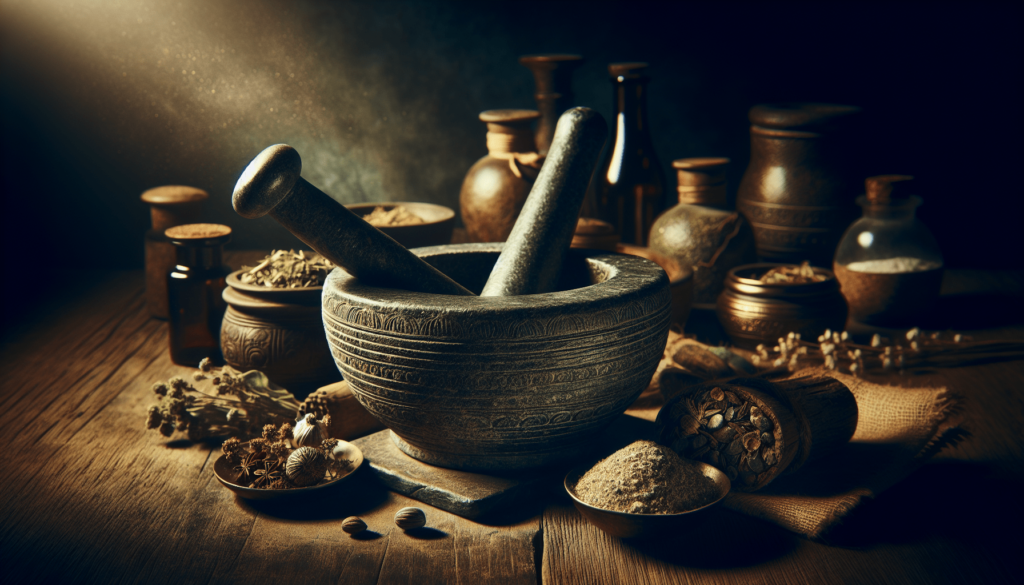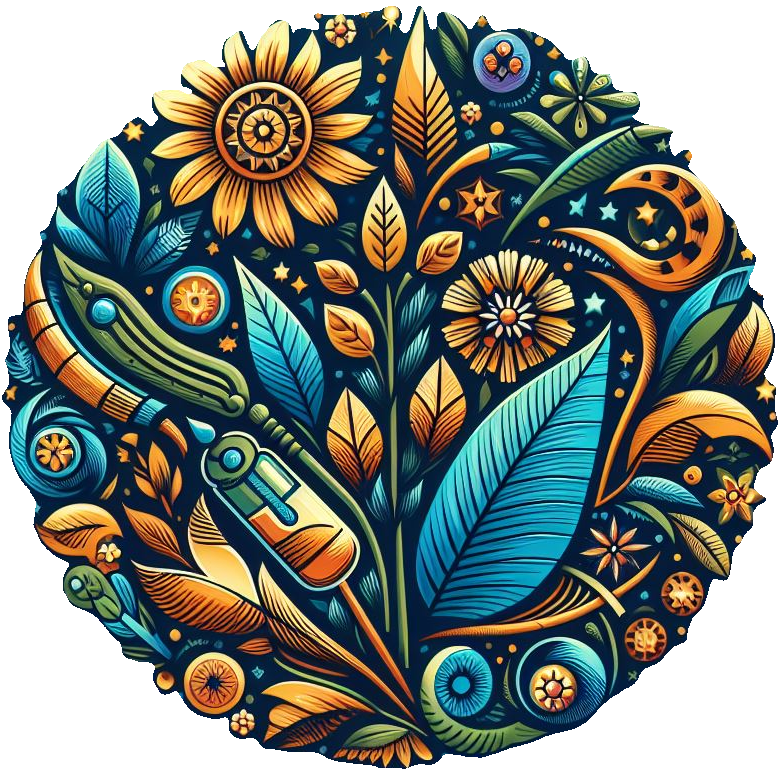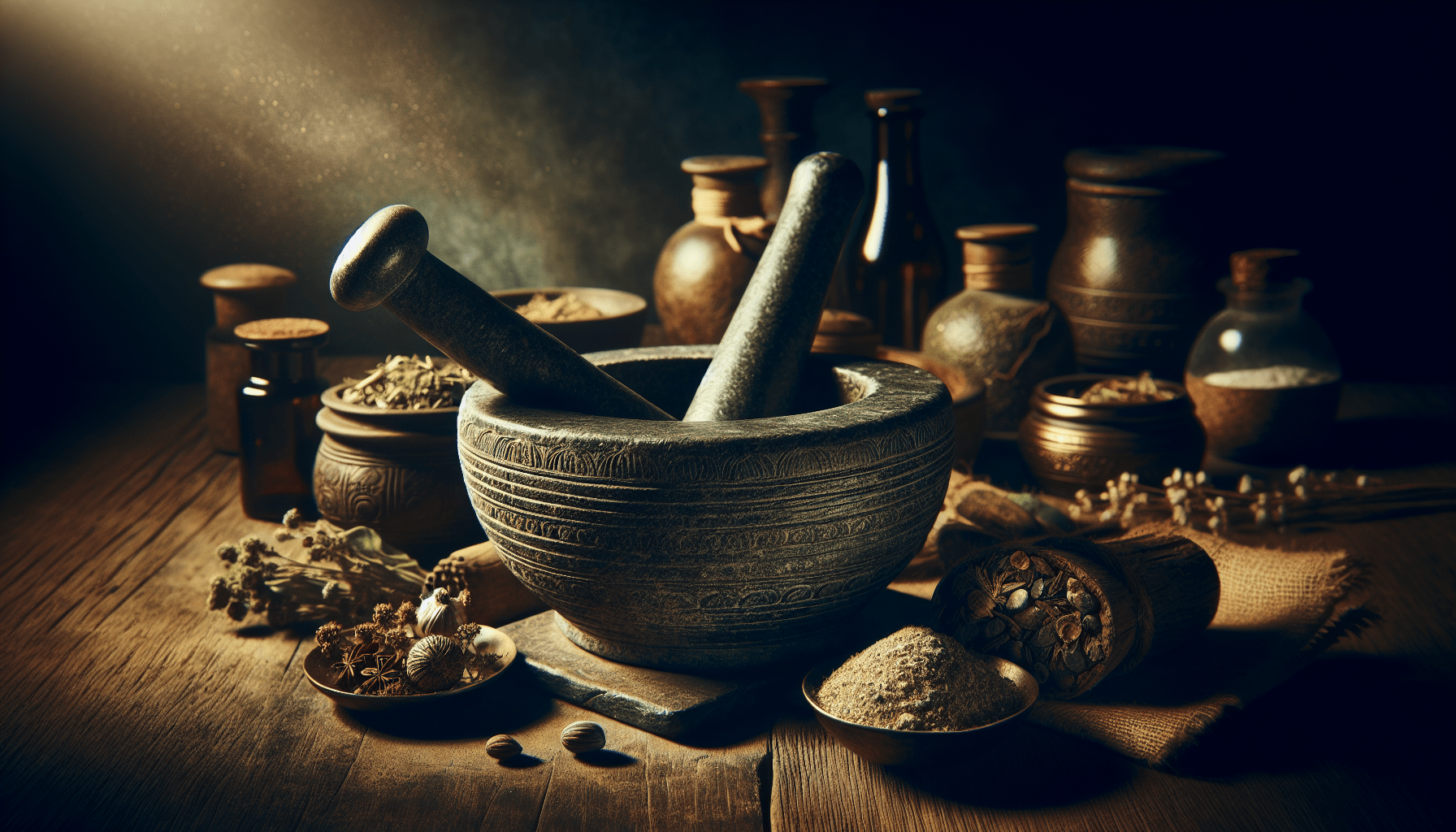So, you’ve probably heard of herbal medicine before, but have you ever wondered about its origins and ancient practices? In this article, we will take a deep dive into the world of herbal medicine traditions, exploring the historical roots of this ancient healing practice and the diverse cultural practices that have been passed down through generations. From the ancient healing practices of Ayurveda in India to the traditional Chinese medicine, we will uncover the fascinating history and beliefs behind these enduring traditions. Get ready to discover the rich tapestry of knowledge and wisdom that has been woven into the fabric of herbal medicine throughout the ages.

Introduction
Herbal medicine has a rich and storied history that spans across cultures and continents. For thousands of years, humans have relied on the healing power of plants to treat ailments and maintain overall wellbeing. From the ancient Egyptians to indigenous tribes in North America, traditional herbal medicine practices have played a vital role in promoting health and longevity. In today’s modern world, herbal medicine continues to be relevant and important, offering a natural alternative to conventional pharmaceuticals. In this article, we will explore the different herbal medicine traditions, their unique practices and remedies, as well as the challenges and controversies surrounding this holistic approach to healthcare.
Traditional Systems of Herbal Medicine
Chinese herbal medicine
Chinese herbal medicine, also known as Traditional Chinese Medicine (TCM), dates back over 2,000 years. Rooted in the concept of balancing Yin and Yang energies, TCM utilizes a vast array of plants, minerals, and animal products to create medicinal formulas. Chinese herbal medicine focuses on treating the underlying causes of illness rather than just the symptoms, and it emphasizes the importance of individualized treatments based on an individual’s unique constitution.
Ayurvedic medicine
Originating in ancient India over 5,000 years ago, Ayurvedic medicine is one of the world’s oldest holistic healing systems. Ayurveda views the body, mind, and spirit as interconnected, and aims to achieve balance through proper nutrition, lifestyle practices, and herbal remedies. Ayurvedic practitioners consider each person’s dosha, or energy type, when prescribing herbal medicines, ensuring personalized treatments that promote overall wellbeing.
Native American herbalism
Native American herbalism is deeply rooted in the traditions and spirituality of indigenous tribes across North America. The use of medicinal plants is an integral part of Native American culture and has been passed down through generations. Herbal remedies are used to treat a wide range of ailments, from physical ailments to emotional and spiritual imbalances. Native American healers often incorporate ceremonial rituals and a deep connection to nature in their practice of herbal medicine.
Egyptian herbalism
The ancient Egyptians were pioneers in the field of herbal medicine, utilizing plants for both medicinal and spiritual purposes. The Ebers Papyrus, an Egyptian medical text dating back to 1550 BCE, contains detailed information on hundreds of medicinal plants and their uses. Egyptian herbalism focused on treating both the physical and spiritual aspects of illness, with herbs being used in various forms such as infusions, ointments, and poultices.
Herbal Medicine Around the World
Traditional practices in different countries
Herbal medicine is not limited to a particular culture or region but is a practice that transcends borders. Each country has its unique herbal medicine traditions, deeply rooted in its history and culture. In traditional African medicine, for example, healers use plants to address physical, emotional, and spiritual imbalances. In the Americas, indigenous tribes have long relied on herbs like echinacea and sage for their healing properties. In Europe, traditional herbal medicine is still practiced in countries like Germany, where herbal remedies are integrated into conventional healthcare systems.
Unique herbal remedies and treatments
Throughout the world, each herbal medicine tradition has its own unique set of remedies and treatments. In Chinese herbal medicine, for instance, herbal formulas often combine multiple ingredients to achieve synergistic effects. Ayurvedic medicine, on the other hand, emphasizes the use of specific herbs and spices to balance each individual’s dosha. Native American herbalism often includes the use of sacred plants and herbs in combination with rituals and ceremonies. Egyptian herbalism, with its deep spiritual roots, focuses on the healing properties of plants within the context of ancient rituals and beliefs.
Commonly Used Medicinal Herbs
Overview of popular medicinal herbs
There are countless medicinal herbs used in herbal medicine traditions around the world. Some of the most commonly used herbs include:
- Ginger: Known for its anti-inflammatory and digestive properties, ginger is often used to relieve nausea, indigestion, and muscle pain.
- Echinacea: Used to boost the immune system, echinacea is often taken to prevent or treat the common cold and other respiratory infections.
- Turmeric: With powerful anti-inflammatory and antioxidant properties, turmeric is often used to reduce inflammation, promote a healthy heart, and support joint health.
- Chamomile: Known for its calming and soothing effects, chamomile is commonly used to promote relaxation, improve sleep, and ease anxiety.
- Garlic: Garlic is renowned for its antimicrobial properties and is often used to boost the immune system and support cardiovascular health.
Benefits and uses of each herb
The benefits and uses of medicinal herbs are vast and varied. Ginger, for example, can alleviate nausea caused by motion sickness or morning sickness during pregnancy. Echinacea is often used to prevent recurrent infections and strengthen the immune system. Turmeric has been shown to reduce inflammation in conditions such as arthritis and promote overall wellbeing. Chamomile is commonly used to promote relaxation and help with sleep disorders. Garlic has antimicrobial properties that can support the immune system and promote heart health. These are just a few examples, and the list of herbs and their uses goes on.
Preparation and Administration of Herbal Medicines
Methods of preparing medicinal herbs
There are several methods of preparing medicinal herbs, depending on the desired form and efficacy. Common methods include:
- Infusions: The most common method of preparing herbal teas, infusions involve steeping herbs in hot water for a certain period to extract their active compounds.
- Decoctions: Similar to infusions, decoctions involve boiling herbs in water for a longer time to extract more potent compounds.
- Tinctures: Tinctures are made by soaking herbs in alcohol or glycerin to extract their medicinal properties. This concentrated liquid is then usually taken in small doses.
- Poultices: Poultices involve applying a paste made from crushed or powdered herbs directly to the skin to treat wounds, inflammation, or skin conditions.
Forms of herbal remedies (teas, tinctures, poultices, etc.)
Herbal remedies come in various forms, each suited to different purposes and preferences. Herbal teas are a popular and accessible form, allowing for easy consumption of medicinal herbs. Tinctures, with their concentrated nature, are often used when a higher dosage is required or when the herb’s active compounds are not easily extracted by water. Poultices are used externally to provide localized relief and promote healing. Other forms include capsules, powders, creams, and oils, each tailored to specific administration methods and desired outcomes.
Dosage and administration guidelines
The dosage and administration of herbal medicines can vary depending on the herb, its potency, and the individual’s specific needs. It is crucial to follow dosage instructions and guidelines from trained herbal practitioners or reputable sources. Factors such as age, weight, overall health, and the severity of the condition being treated should be taken into account. When in doubt, consulting with a qualified herbalist or healthcare professional can ensure safe and effective use of herbal medicines.
Herbal Medicine and Modern Science
Scientific research on herbal medicine
In recent years, there has been a growing body of scientific research focused on the effectiveness and safety of herbal medicine. Studies are conducted to validate the traditional claims associated with specific herbs, explore their mechanisms of action, and identify potential interactions or side effects. Scientific research aims to bridge the gap between traditional herbal medicine and modern healthcare by providing evidence-based information on the efficacy and safety of herbal remedies.
Validating traditional claims through modern studies
Modern scientific studies have often confirmed the efficacy of traditional herbal remedies. For example, research has shown that ginger can effectively reduce symptoms of nausea and vomiting, validating its traditional use for digestive issues. Echinacea has been found to stimulate the immune system and reduce symptom severity and duration of the common cold. Turmeric’s anti-inflammatory properties have been supported by numerous studies, linking it to potential benefits in managing chronic inflammatory conditions. By validating traditional claims through modern studies, herbal medicine gains recognition and credibility in mainstream healthcare systems.
Controversies and Challenges in Herbal Medicine
Safety concerns and potential side effects
While herbal medicine offers many benefits, there are also safety concerns and potential side effects to be aware of. Like any form of healthcare, herbal remedies can interact with medications, cause allergic reactions, or have unwanted effects if not used properly. The quality and purity of herbal products can also vary, leading to inconsistencies in dosage and effectiveness. It is crucial to source herbal remedies from reputable suppliers and consult with a qualified healthcare professional to minimize the risks and ensure safe usage.
Regulation and standardization of herbal products
Regulation and standardization of herbal products is a challenge faced by the herbal medicine community. The lack of consistent regulations and quality control measures makes it difficult for consumers to trust the safety and efficacy of herbal remedies. However, efforts are being made to establish guidelines and standards for the manufacturing, labeling, and marketing of herbal products. Compliance with Good Manufacturing Practices (GMP) and certifications from reputable organizations can help ensure the quality and authenticity of herbal medicines.
Integration of traditional and modern healthcare systems
Integrating traditional herbal medicine with modern healthcare systems poses challenges due to the differences in paradigms and approaches. There is a need for mutual respect and cooperation between traditional healers and Western-trained healthcare professionals. Collaboration between the two can lead to more comprehensive and patient-centered care, combining the best of both worlds and offering a holistic approach to healing.
Herbal Medicine Practices for Specific Conditions
Herbal remedies for common ailments
Herbal medicine provides an array of remedies for common ailments. For colds and respiratory infections, herbs like elderberry and thyme can help boost the immune system and alleviate symptoms. Ginger and peppermint are commonly used for digestive issues such as nausea, indigestion, and bloating. To promote better sleep and manage stress, herbs like valerian, passionflower, and lavender can be used. These are just a few examples, and there are countless herbal remedies available for various common ailments.
Herbal medicine for chronic conditions
Herbal medicine also offers support for managing chronic conditions. For individuals with diabetes, herbs such as bitter melon and cinnamon can help regulate blood sugar levels naturally. Turmeric, ginger, and boswellia are often used to manage symptoms of arthritis and reduce inflammation. Herbs like ginkgo biloba and gotu kola may improve cognitive function and memory for individuals with Alzheimer’s disease or age-related cognitive decline. It is essential to work closely with a qualified herbalist or healthcare professional to develop an individualized treatment plan for chronic conditions.
Cultural and Spiritual Significance of Herbal Medicine
Herbal medicine as a part of cultural heritage
Herbal medicine holds significant cultural importance and is often intertwined with a community’s history and traditions. It embodies the wisdom and knowledge passed down through generations, reflecting the cultural identity of a group of people. The preservation and promotion of herbal medicine traditions are essential in maintaining cultural heritage and fostering a sense of identity and pride.
Rituals and ceremonies involving herbal medicine
Herbal medicine is not merely a physical practice but often includes rituals and ceremonies that have spiritual significance. For example, smudging with sage is a common practice among Native American tribes, used to purify the energy in a space or an individual. In Ayurveda, the preparation and consumption of herbal medicines may be accompanied by specific chants or prayers to enhance their healing properties. These rituals and ceremonies add depth and meaning to the practice of herbal medicine, connecting individuals to their heritage and spirituality.
Exploring Herbal Medicine in Alternative Therapies
Herbal medicine in conjunction with other alternative therapies
Herbal medicine is often used in conjunction with other alternative therapies to provide a well-rounded approach to healing. Acupuncture, for example, is commonly combined with herbal medicine in traditional Chinese medicine to address both the energetic imbalances and physical symptoms of a condition. Homeopathy, another alternative therapy, may incorporate specific herbal remedies in its treatment protocols. These synergistic combinations create a comprehensive approach to healthcare, addressing the individual’s physical, emotional, and energetic needs.
Synergy between herbal remedies and other treatment modalities
The synergy between herbal remedies and other treatment modalities can enhance their effectiveness and provide a more holistic approach to healing. For example, herbal remedies used in conjunction with dietary changes and lifestyle modifications can have a profound impact on overall health and wellbeing. Integrating herbal medicine with mainstream healthcare, through collaboration with healthcare providers, can also lead to a more integrated and patient-centered approach to treatment. The combination of different treatment modalities helps to address the root causes of health issues and promote long-term wellness.
In conclusion, herbal medicine is an ancient practice that continues to be important and relevant in today’s world. Its rich history, diverse traditions, and unique remedies offer a holistic approach to healthcare that goes beyond treating symptoms. The scientific research conducted on herbal medicine helps validate its traditional claims and bridge the gap between traditional and modern healthcare systems. While there are controversies and challenges associated with herbal medicine, efforts are being made to regulate and standardize this ancient practice. Herbal medicine not only addresses physical ailments but also holds cultural and spiritual significance, enriching the lives of those who practice it. By exploring herbal medicine in alternative therapies and utilizing the synergy between different treatment modalities, we can unlock its full potential in promoting health, wellbeing, and a deeper connection to nature.

